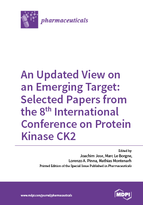An Updated View on an Emerging Target: Selected Papers from the 8th International Conference on Protein Kinase CK2
A special issue of Pharmaceuticals (ISSN 1424-8247).
Deadline for manuscript submissions: closed (30 November 2016) | Viewed by 127661
Special Issue Editors
Interests: autodisplay; assay development and inhibitor testing; whole cell biocatalysts for synthesis of drugs and building blocks; directed evolution of enzyme inhibitors and biocatalysts; biosensor development and diagnostic tools
Special Issues, Collections and Topics in MDPI journals
Interests: ligand-based drug design; small molecules; heterocycles; glycoconjugates; structure-activity relationships; structural optimization; stability studies; cancer; chemoresistances; infectious diseases
Interests: protein phosphorylation in signal transduction; structure-function analysis and definition of specificity determinants of protein kinases implicated in cell proliferation and apoptosis. molecules currently in focus are a number of pleiotropic acidophilic Ser/Thr kinases, notably CK2, CK1, and Dyrk
Special Issue Information
Dear Colleagues,
The 8th International Conference on Protein Kinase CK2 (www.uks.eu/ck2), organized by Matthias Montenarh and Claudia Götz, will be held at the Faculty of Medicine of Saarland University, in Homburg, Germany, from 6–9 September, 2016.
Protein kinase CK2 is a serine/threonine kinase, which is highly conserved in evolution. Knock-out experiments have shown that this enzyme is absolutely necessary for cell viability. The enzyme is highly expressed in rapidly proliferating cells, which goes along with an elevated enzyme activity. Protein kinase CK2 is involved in a broad range of signaling pathways, regulating proliferation, differentiation, apoptosis, or senescence. Recent advances towards the characterization of the three-dimensional structure of protein kinase CK2 and its subunits will undoubtedly yield important new insights into its regulation, and the functions of CK2. Moreover, with two inhibitors of the enzyme presently in clinical phase II trials, human protein kinase CK2 has appeared as an emerging target for cancer diseases.
Speakers at the conference are cordially invited to contribute original research papers or reviews to this Special Issue of Pharmaceuticals.
Prof. Dr. Joachim Jose
Prof. Dr. Marc Le Borgne
Prof. Dr. Lorenzo A. Pinna
Prof. Dr. Mathias Montenarh
Guest Editors
Manuscript Submission Information
Manuscripts should be submitted online at www.mdpi.com by registering and logging in to this website. Once you are registered, click here to go to the submission form. Manuscripts can be submitted until the deadline. All submissions that pass pre-check are peer-reviewed. Accepted papers will be published continuously in the journal (as soon as accepted) and will be listed together on the special issue website. Research articles, review articles as well as short communications are invited. For planned papers, a title and short abstract (about 100 words) can be sent to the Editorial Office for announcement on this website.
Submitted manuscripts should not have been published previously, nor be under consideration for publication elsewhere (except conference proceedings papers). All manuscripts are thoroughly refereed through a single-blind peer-review process. A guide for authors and other relevant information for submission of manuscripts is available on the Instructions for Authors page. Pharmaceuticals is an international peer-reviewed open access monthly journal published by MDPI.
Please visit the Instructions for Authors page before submitting a manuscript. The Article Processing Charge (APC) for publication in this open access journal is 2900 CHF (Swiss Francs). Submitted papers should be well formatted and use good English. Authors may use MDPI's English editing service prior to publication or during author revisions.
Keywords
- protein kinase
- cancer disease
- signal transduction
- therapeutic target
- structural biology









